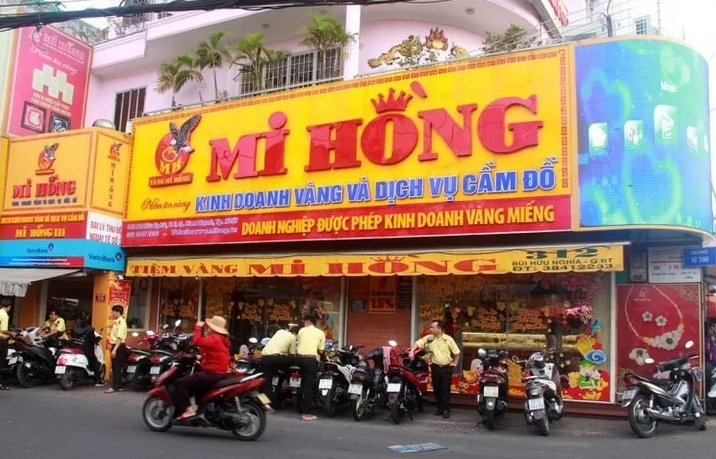Central Vietnamese Cuisine: 10 Signature Dishes You Must Try Once
Date: 2025.10.15
Central Vietnamese Cuisine: 10 Signature Dishes You Must Try Once
Introduction to Central Vietnamese Cuisine
When it comes to Vietnamese cuisine, Central Vietnam has always been an indispensable highlight – where the essence of bold, refined, and distinctively strong flavors converge in every dish.
The Central region stretches from Thanh Hoa to Binh Thuan, with each area possessing its own unique culinary identity. Each dish not only reflects the harsh climate and diverse terrain but also clearly demonstrates the resilient, frugal, and creative spirit of the local people.
What makes Central Vietnamese cuisine distinctive is its boldness in blending spices – especially fish sauce and chili – while maintaining harmony and depth. Central Vietnamese people don’t just “eat spicy,” they also know how to “eat deeply,” meaning each dish has layers of flavor and stories behind it.
Let’s explore 10 signature dishes you cannot miss when setting foot in Central Vietnam – from time-honored establishments in their homeland to famous restaurants bringing Central Vietnamese flavors to Ho Chi Minh City.
1. Mi Quang – The culinary essence of Quang Nam
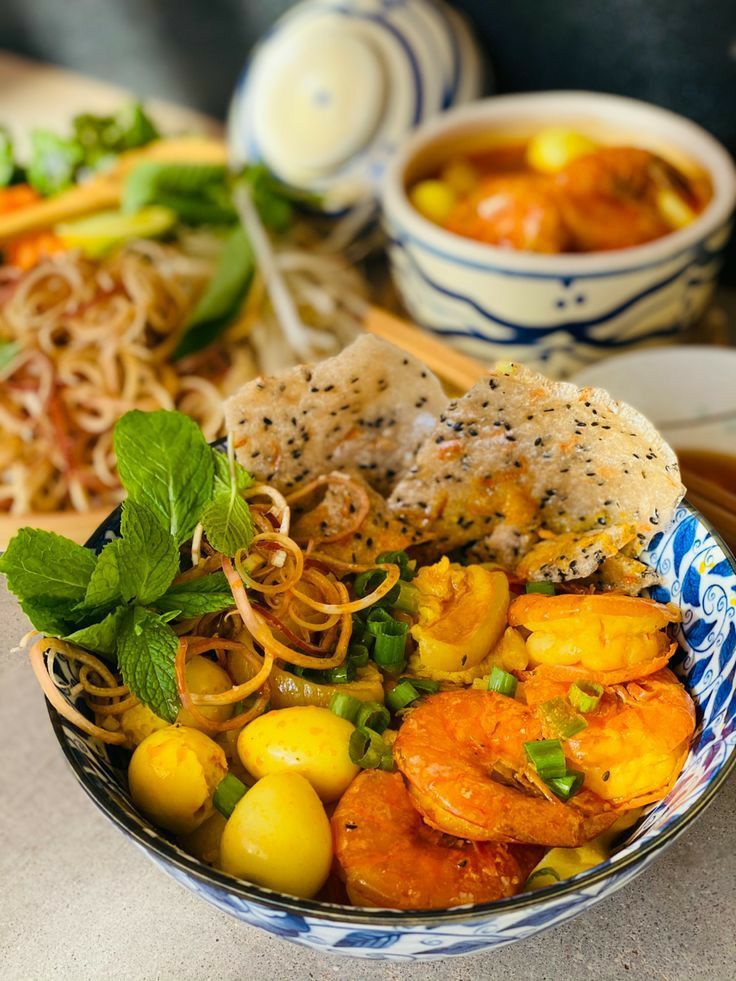
Mi Quang is a famous specialty of Quang Nam, widely beloved in Da Nang and other Central Vietnamese provinces. A rich bowl of Mi Quang features soft noodles, usually white or light yellow, combined with fragrant broth served in just the right amount, fresh green vegetables, and crispy roasted peanuts.
What makes Mi Quang special is the harmonious combination of noodles with various toppings like shrimp, sliced pork, shredded chicken, boiled eggs, roasted peanuts, fresh vegetables (Vietnamese balm, green cabbage, bean sprouts), and grilled rice paper. The broth is made from pork bones and dried shrimp, sometimes with fermented shrimp paste or other ingredients like crab or chicken, creating a rich yet light flavor that differs from noodle soups served with abundant broth like pho.
Where to enjoy delicious Mi Quang:
In Central Vietnam:
- Mi Quang Que Xua
📍 165 Nui Thanh Street, Hoa Cuong Ward, Da Nang (formerly Hoa Cuong Bac Ward, Hai Chau District) - My Quang Thanh Ha
📍 551 Tran Cao Van Street, Tam Ky Ward, Da Nang (formerly Truong Xuan Ward, Tam Ky District, Quang Nam Province)
In Saigon:
- Mi Quang Ba Mua
📍 Lane 60A Le Thi Rieng Street, Ben Thanh Ward, Ho Chi Minh City (formerly Pham Ngu Lao Ward, District 1) - Mi Quang My Son Restaurant
📍 38B Dinh Tien Hoang Street, Tan Dinh Ward, Ho Chi Minh City (formerly Da Kao Ward, District 1)
📍 9A Ky Dong Street, Nhieu Loc Ward, Ho Chi Minh City (formerly Ward 9, District 3)
2. Bun Bo Hue – Royal flavors of the ancient capital
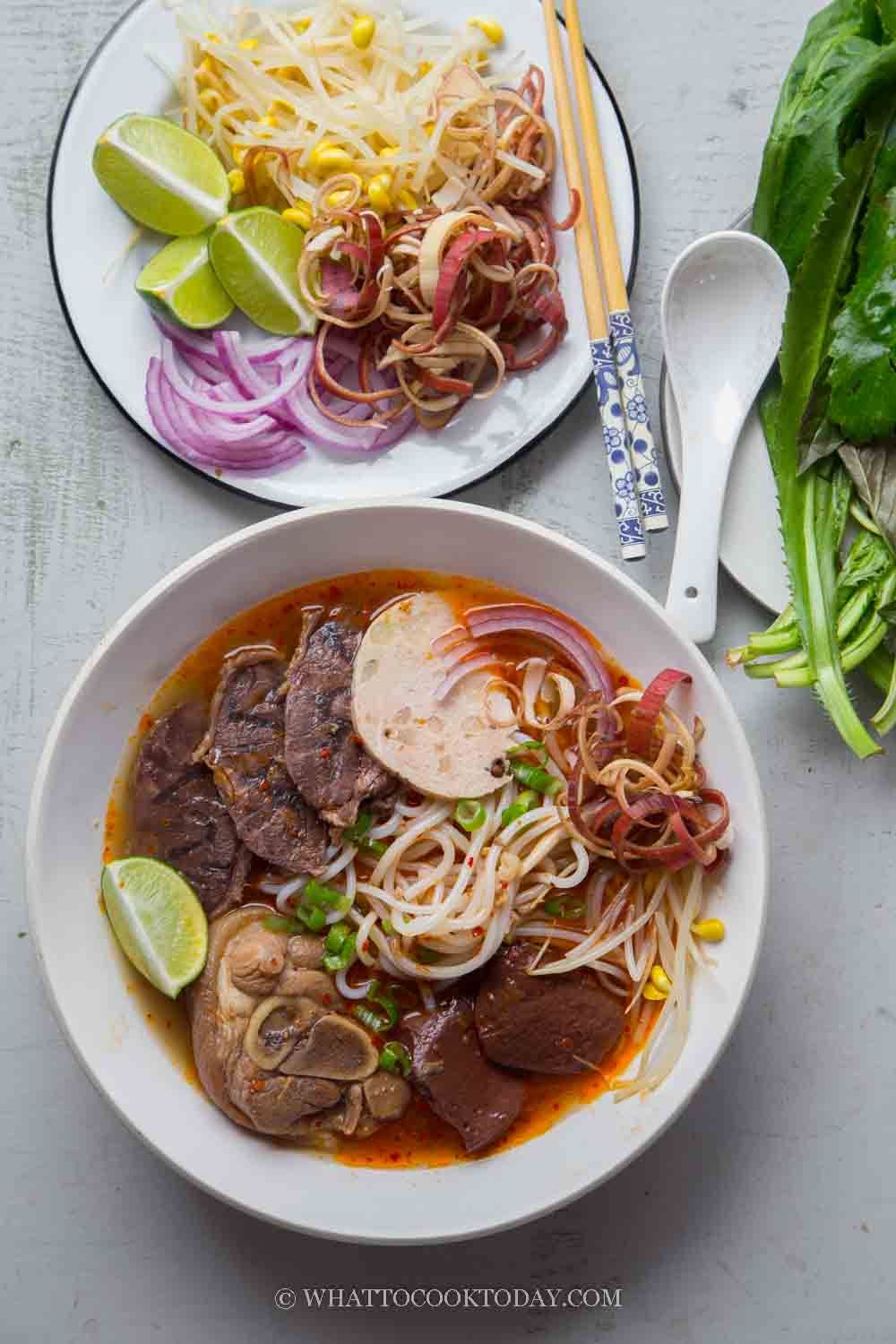
Bun Bo Hue is the symbol of the ancient capital’s cuisine, a dish that captivates visitors to Central Vietnam. What makes Bun Bo Hue special is its unique taste that cannot be confused with other noodle soups due to the distinctive flavor of fermented shrimp paste and lemongrass. When enjoyed, it has a gentle sweet taste and pleasant aroma that’s not overpowering or fishy.
The broth of Bun Bo Hue is simmered from pork and beef bones with lemongrass and fermented shrimp paste, creating a rich, spicy characteristic flavor. The thick, chewy noodles combined with beef, crab cake, and pork sausage create a nutritious bowl.
Where to enjoy delicious Bun Bo Hue:
In Central Vietnam:
- Bun Bo Ba Tuyet
📍 47 Nguyen Cong Tru Street, Thuan Hoa Ward, Hue (formerly Phu Hoi Ward) - Bun Bo Hue O Phuong
📍 24 Nguyen Khuyen Street, Thuan Hoa Ward, Hue (formerly Phu Nhuan Ward)
In Saigon:
- Bun Bo Hue Nam Giao
📍 242 De Tham Street, Ben Thanh Ward, Ho Chi Minh City (formerly Pham Ngu Lao Ward, District 1) - Bun Bo Hue Dong Ba
📍 207B Nguyen Van Thu Street, Tan Dinh Ward, Ho Chi Minh City (formerly Da Kao Ward, District 1)
🌐 bunbodongba.vn
3. Tre Tron – The “addictive” delicacy of Central Vietnam
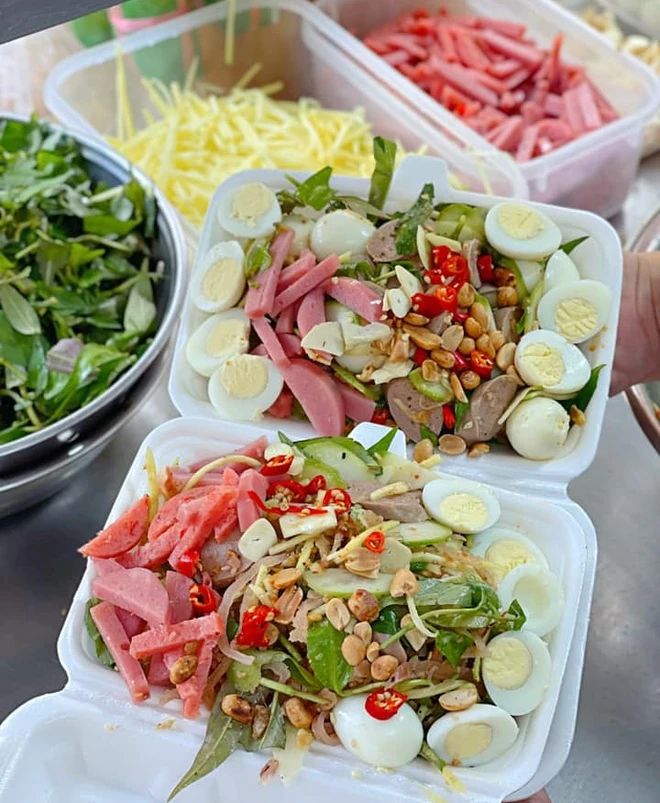
Tre tron is an extremely popular snack in Central provinces like Da Nang, Hue, and Binh Dinh. With the main ingredient being tre – a type of fermented sausage made from minced pork ears, pork belly, and pork skin mixed with roasted rice powder, galangal, sesame, and special seasonings – tre tron offers a uniquely tangy, crispy, and rich flavor.
The dish’s appeal lies in mixing it with Vietnamese coriander, shredded green mango, pickled papaya, cucumber, chili, garlic, and especially grilled sesame rice paper or rice crackers to add crispiness and aroma. Some places also add fermented pork roll, beef jerky, and boiled quail eggs to make the dish more appealing and substantial.
Tre tron often appears at drinking sessions, light parties, or simply as an afternoon snack. The harmonious blend of sour – spicy – salty – sweet flavors makes it addictive after just one taste – which is why this dish has become an “addictive specialty” not to be missed when visiting Central Vietnam.
Where to enjoy delicious Tre Tron:
In Central Vietnam:
- Tre Tron – Food Em Chang
📍 107 Be Van Dan Street, Thanh Khe Ward, Da Nang (formerly Chinh Gian Ward, Thanh Khe District) - Quy Nhon Food Street
📍 07 Ngo Van So Street, Quy Nhon Ward, Gia Lai (formerly Tran Phu Ward, Quy Nhon City, Binh Dinh Province)
In Saigon:
- Tre Tron Giang Hoang
📍 285 Nguyen Thuong Hien Street, Ban Co Ward, Ho Chi Minh City (formerly Ward 4, District 3) - 7 Kho
📍 98B Ly Thai To Street, Ban Co Ward, Ho Chi Minh City (formerly Ward 2, District 3)
4. Com Hen – Rustic flavors of the ancient capital
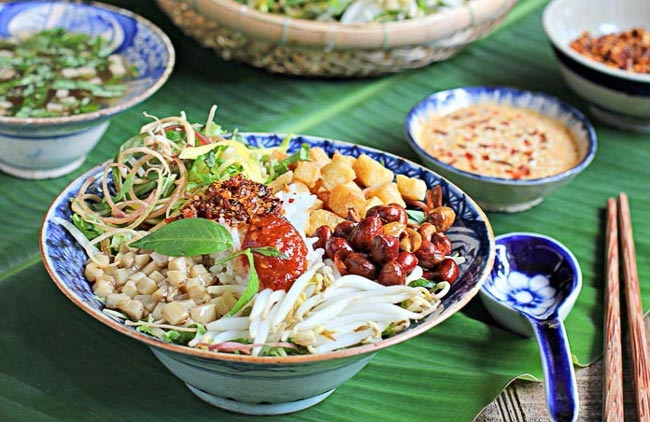
Com hen is a dish that carries the rich imperial flavor yet originates from the rustic life of Hue ancient capital residents. Though just cold rice eaten with stir-fried baby clams, fresh vegetables, roasted peanuts, and pork cracklings, thanks to skillful seasoning and ingredient mixing, this dish becomes special and strangely captivating.
Baby clams – the main ingredient – are boiled and the meat extracted, then stir-fried with onions, pepper, fermented shrimp paste, and characteristic seasonings. The rice is naturally cooled, eaten with herbs, bean sprouts, sour star fruit, thinly sliced banana flower, crushed peanuts, and hot clam broth poured over. Everything harmonizes to create a culinary symphony that’s delicious – crispy – fatty – spicy – salty – sweet, truly Hue-style.
Though a common dish, com hen still carries the elegance and refinement – a typical representative of the ancient capital’s culinary spirit that any visitor to Hue should try at least once.
Where to enjoy delicious Com Hen:
In Central Vietnam:
- Com Hen Hoa Dong
📍 64/7 Ung Binh Street, Vy Da Ward, Hue
🌐 Com Hen Hoa Dong - Com Hen 17
📍 17 Han Mac Tu Street, Vy Da Ward, Hue
🌐 Com Hen 17
In Saigon:
- Thanh Thu 284
📍 284 Le Van Sy Street, Bay Hien Ward, Ho Chi Minh City (formerly Ward 14, District 3) - Hue Restaurant O Xuan
📍 22 Nguyen Huu Cau Street, Tan Dinh Ward, Ho Chi Minh City (formerly District 1)
🌐 Hue Restaurant O Xuan
5. Nem Chua – The “wrapped” dish with sour-spicy flavors of Central Vietnam
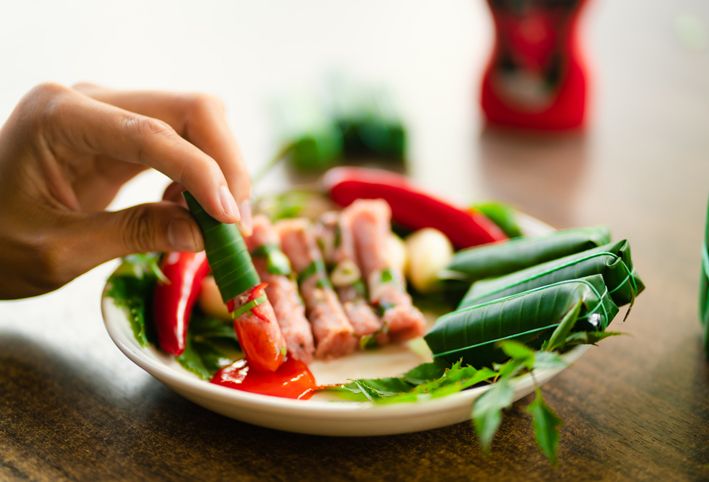
Nem chua is one of the famous dishes that cannot be unmentioned when talking about Central Vietnamese cuisine, especially Thanh Hoa – the land considered the “capital” of nem chua. Made from minced lean pork mixed with shredded pork skin, roasted rice powder, garlic, pepper, chili, then wrapped in banana or guava leaves and naturally fermented for several days.
When ready, nem has a mild sour taste, crispy texture, and aromatic spiciness from chili and garlic that’s very appetizing. Depending on the region, nem is wrapped in square, round, or long shapes, eaten raw as a drinking snack or dipped with chili sauce or sweet and sour fish sauce. Additionally, many places transform it into grilled or fried nem for variety.
Though a snack, nem chua embodies the spirit of Central Vietnamese cuisine – rustic, bold, harmonious in flavors, and especially “addictive” to anyone who has tried it.
Where to enjoy delicious Nem Chua:
In Central Vietnam:
- Nem Chua Hanh Kinh
📍 17B Le Huu Lap Street, Hac Thanh Ward, Thanh Hoa (formerly Lam Son Ward) - Nem Chua Sinh Tuyen
📍 101 Le Thanh Tong Street, Hac Thanh Ward, Thanh Hoa (formerly Dong Ve Ward)
🌐 nemngonthanhhoa.com
In Saigon:
- Hue Banh Beo Thien Huong Restaurant
📍 12/1 Lu Gia Street, Phu Tho Ward, Ho Chi Minh City (formerly Ward 15, District 11) - Hang Nem Me Gui
📍 34 Street 12, Thu Duc Ward, Ho Chi Minh City (formerly Truong Tho Ward, Thu Duc City)
6. Bun Ca Nha Trang – Ocean flavors
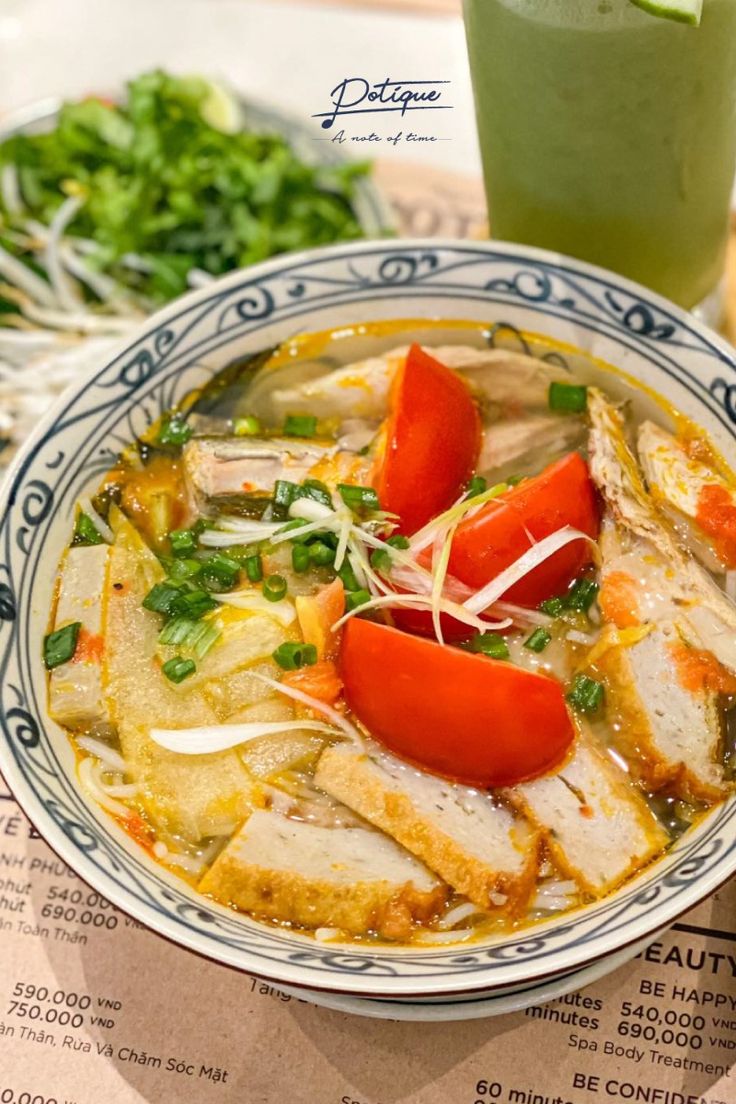
As a famous coastal city, Nha Trang captivates visitors not only with its beautiful scenery but also with dishes rich in ocean flavors – prominently bun ca Nha Trang.
The distinctive feature that makes this dish attractive is the sweet and clear broth cooked from fresh fish heads and bones, not fishy at all but fragrant with ocean flavors. The noodles used are fresh thin rice noodles, served with Nha Trang fish cake – hand-ground from tuna, sailfish… either fried or steamed, chewy and flavorful. Additionally, some places add boiled fish meat and fresh jellyfish for extra appeal.
The noodle bowl is usually garnished with onions and cilantro, a bit of pickled chili, served with fresh vegetables and pure fish sauce. The sweet freshness from fish, slight spiciness from chili, and crisp coolness of fresh vegetables make the dish not only delicious but also very “cooling” – especially suitable for summer days in Central Vietnam.
Where to enjoy delicious Bun Ca Nha Trang:
In Central Vietnam:
- Bun Ca Nguyen Loan
📍 123 Ngo Gia Tu Street, Nha Trang Ward, Khanh Hoa (formerly Tan Tien Ward, Nha Trang City) - Bun Ca Hai Ca
📍 156 Nguyen Thi Minh Khai Street, Nha Trang Ward, Khanh Hoa (formerly Phuoc Hoa Ward, Nha Trang City)
In Saigon:
- Bun Ca Yen Nha Trang
📍 410-412 An Duong Vuong Street, Cho Quan Ward, Ho Chi Minh City (formerly Ward 4, District 5) - Bun Ca Ninh Hoa Ky Dong
📍 17 Ky Dong Street, Nhieu Loc Ward, Ho Chi Minh City (formerly Ward 9, District 3)
7. Chao Luon Nghe An – Spicy and rich flavors of Nghe An Province
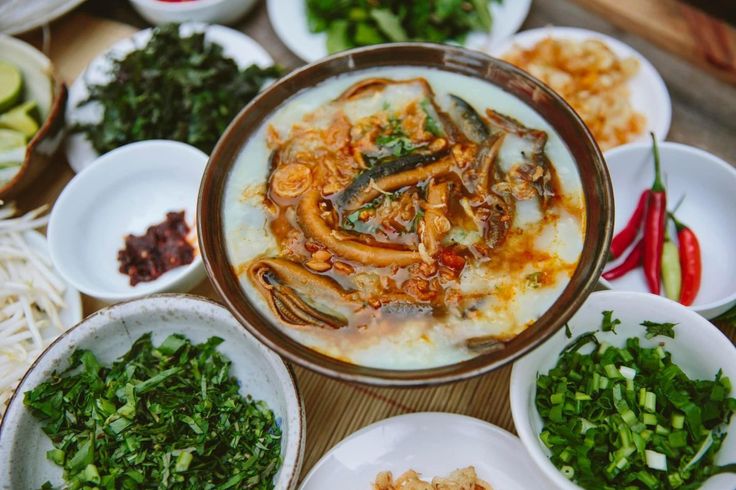
Chao luon Nghe An is a rustic but outstanding dish of Central Vietnam, carrying the distinctive culinary identity of Nghe province. The dish’s characteristic lies in rice porridge cooked until smooth and creamy, combined with field eel meat stir-fried with turmeric, shallots, and hot chili to bring out the aroma and natural sweet richness.
The spicy heat from pepper, shallots, fresh chili, and chopped Vietnamese coriander is the “soul” of the dish, making diners slurp with delight while still wanting to finish every last spoon. The porridge is often eaten with crispy bread or grilled rice crackers – creating an interesting textural contrast with the smooth porridge.
Not only delicious, chao luon Nghe An is also a nutritious dish used by locals for health restoration – definitely a dish you shouldn’t miss.
Where to enjoy delicious Chao Luon Nghe An:
In Central Vietnam:
- Chao Luon Ba Ngo
📍 No. 1 Lane 04 Doc Thiet, Thanh Vinh Ward, Vinh City, Nghe An (formerly Hung Binh Ward) - Chao Luon Ba Lieu
📍 Street 77, Lane 3, Vinh Hung Ward, Vinh City, Nghe An (formerly Quan Bau Ward)
In Saigon:
- Luon Nieu Xu Nghe
📍 108 Street 79, Tan Hung Ward, Ho Chi Minh City (formerly Tan Quy Ward, District 7) - Luon Xu Nghe 37
📍 282 Ly Thuong Kiet Street, Dien Hong Ward, Ho Chi Minh City (formerly Ward 14, District 10)
8. Banh Canh He – Rich flavors of the land of yellow flowers and green grass

Banh canh he impresses from first sight with the distinctive green color of finely chopped scallions covering the hot noodle bowl.
The noodle strands are usually made from rice flour or tapioca starch, perfectly chewy and soft. The broth is simmered from bones or fish, with a sweet and clear taste, not greasy. The distinctive topping is Phu Yen fish cake – chewy, aromatic, rich with ocean flavors. Some places also add quail eggs, shrimp, and ground meat according to taste.
Scallions not only create eye-catching colors but also bring distinctive aroma and mild pungent taste, harmoniously combining with the broth and noodles to create a refreshing, easy-to-eat whole with strong local character.
Phu Yen banh canh he is proof of the beauty of Central Vietnamese cuisine – simple, unpretentious but refined and memorable in every small detail.
Where to enjoy delicious Banh Canh He:
In Central Vietnam:
- Banh Canh He Thanh Tam
📍 53 Dien Bien Phu Street, Tuy Hoa Ward, Dak Lak (formerly Ward 7, Tuy Hoa City, Phu Yen Province) - Banh Canh He Thao Vy
📍 393 Hung Vuong Boulevard, Tuy Hoa Ward, Dak Lak (formerly Ward 9, Tuy Hoa City, Phu Yen Province)
In Saigon:
- Banh Canh He – Bun Ca Phu Yen
📍 18A/4 Nguyen Thi Minh Khai Street, Saigon Ward, Ho Chi Minh City (formerly Da Kao Ward, District 1) - He Quan
📍 113 Cao Thang Street, Dien Hong Ward, Ho Chi Minh City (formerly Ward 10, District 10)
9. Banh Xeo – Simple but no less appealing
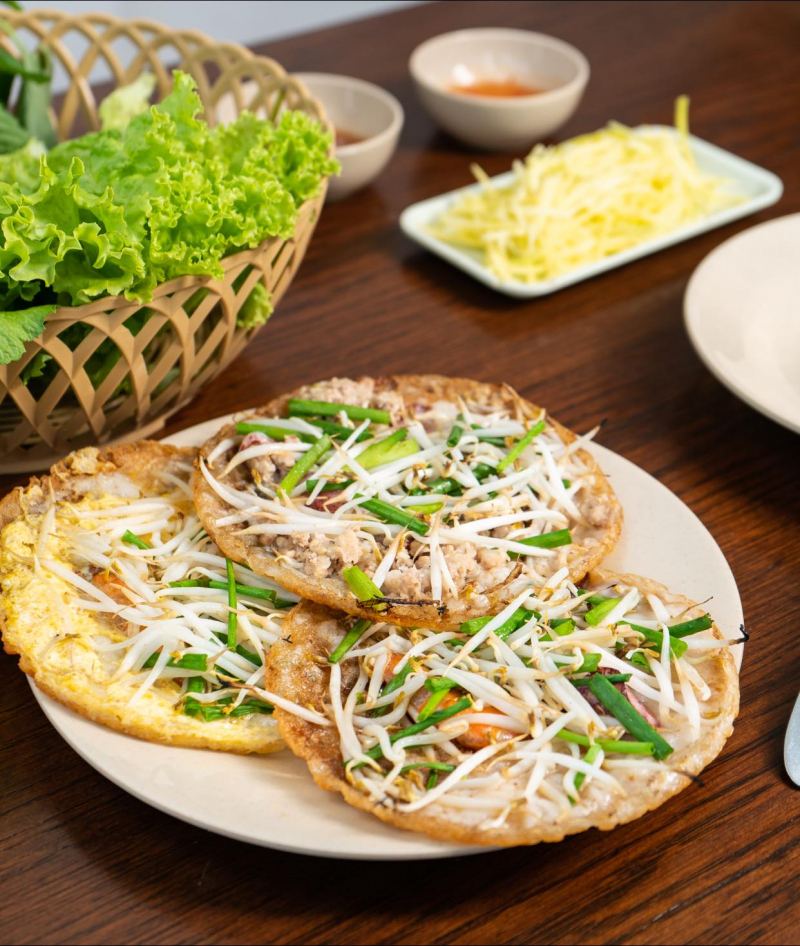
Central Vietnamese banh xeo is a rustic but captivating dish found throughout provinces like Hue, Quang Nam, Da Nang, and Binh Dinh. Unlike the large and crispy Southern banh xeo, Central Vietnamese banh xeo is usually small, with thin and soft skin that’s pure white or slightly yellow, lightly crispy at the edges.
The filling is a harmonious combination of fresh sea shrimp, thinly sliced pork, crispy bean sprouts, sometimes with squid or quail eggs depending on the region. The batter is poured directly onto a hot cast iron mold, lightly absorbing scallion oil, creating an aromatic, fatty, soft pancake skin that’s not greasy.
When eating, the pancake is wrapped with fresh vegetables like Vietnamese basil, lettuce, and young cabbage, then dipped in sweet and sour garlic chili fish sauce, creating an explosion of flavors: fatty – aromatic – salty – sweet – spicy – fresh, all in one small wrap.
Central Vietnamese banh xeo is not just a dish, but also a hometown culinary memory, wrapped in each small, simple yet appealing pancake.
Where to enjoy delicious Banh Xeo:
In Central Vietnam:
- Banh Xeo Tom Nhay Ong Hung
📍 230 Xuan Dieu Street, Quy Nhon Ward, Gia Lai (formerly Tran Phu Ward, Quy Nhon City, Binh Dinh Province)
🌐 foody.vn/binh-dinh/ong-hung-banh-xeo-tom-nhay - Hong Sinh Quan
📍 My Khe Beach Tourist Area, Tinh Khe Commune, Quang Ngai
🌐 bienmykhe.com
In Saigon:
- Phan Rang Quan
📍 399 Le Van Luong Street, Phu Thuan Ward, District 7, Ho Chi Minh City
🌐 Phan Rang Quan - Xom Cho Cu Restaurant
📍 35 Ly Tu Trong Street, Saigon Ward, Ho Chi Minh City (formerly Ben Nghe Ward, District 1)
10. Keo Cu Do Ha Tinh – Crispy sweet flavors wrapped in countryside love of Nghe An Province
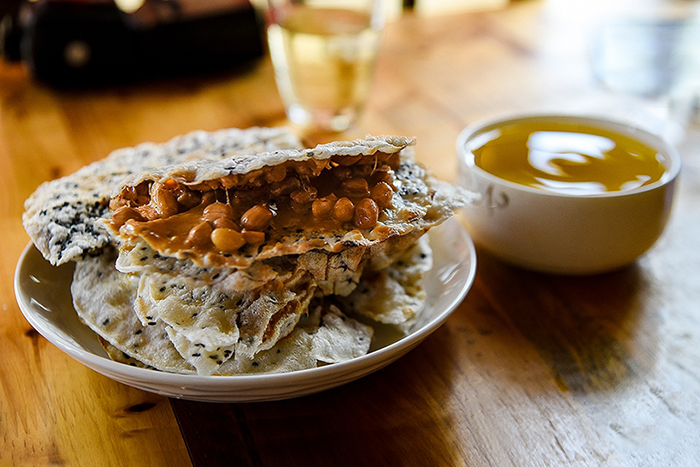
Keo cu do is a famous specialty of Ha Tinh and Nghe An, associated with childhood memories and the simple culinary culture of Central Vietnamese people. This candy appears modest – consisting only of crispy roasted peanuts, malt, fresh ginger, molasses sugar, and two layers of rice paper wrapping – but makes anyone who has tasted it unforgettable.
The candy piece combines the crispiness of rice paper, the chewy sweetness of sugarcane molasses, the buttery richness of peanuts, and the warm spiciness of ginger, creating a unique harmony. When bitten, the crispy sound rings out, followed by spreading aroma in the mouth – simple but captivating.
Keo cu do is not just a snack but also a meaningful hometown gift, often used to treat guests or given as presents during trips away from home. This is truly a confection crystallized from the simplicity, skillfulness, and affection of Nghe province people.
Where to enjoy delicious Keo Cu Do:
In Central Vietnam:
- Cu Do Thu Vien Ha Tinh
📍 481 Ha Huy Tap Street, Dai Nai Ward, Ha Tinh - Cu Do Phong Nga
📍 37 Quan Gac Street, Ha Huy Tap Ward, Ha Tinh (formerly Thach Dai Commune, Thach Ha Town)
🌐 cudophongnga.com
In Saigon:
- Champa Shop
📍 160/9 Street 4, An Hoi Dong Ward, Ho Chi Minh City (formerly Ward 16, Go Vap District)
🌐 champashop.com
Conclusion
Central Vietnamese cuisine with these 10 signature dishes is not just delicious food but also cultural stories and precious culinary heritage of the nation. From the characteristic spicy heat to the harmony in every flavor – everything creates a diverse and rich culinary picture.
Whether you’re in Central Vietnam or Saigon, the addresses introduced above will help you enjoy the authentic flavors of Central Vietnamese dishes. Take time to experience each dish to fully feel the culinary essence of this tradition-rich land.
Central Vietnamese cuisine is not just food, but an entire culture, a way of life, and a pride of Central Vietnamese people. Each dish carries its own story, its own flavor, and its own way of enjoyment – all worth exploring and experiencing at least once in your lifetime.





